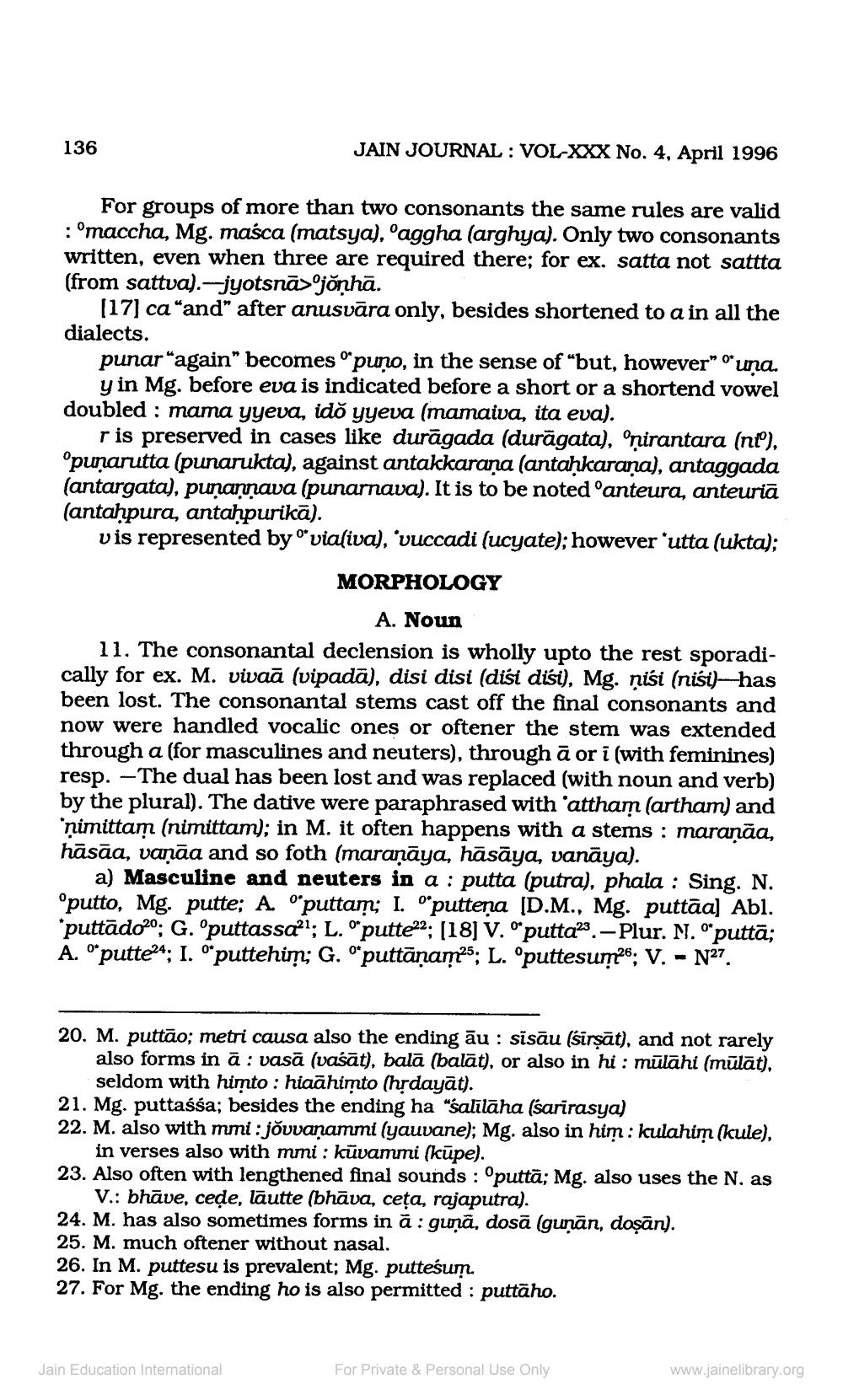________________
136
JAIN JOURNAL : VOL-XXX No. 4, April 1996
For groups of more than two consonants the same rules are valid : 'maccha, Mg. masca (matsya), 'aggha (arghya). Only two consonants written, even when three are required there; for ex. satta not sattta (from sattva). --jyotsnā> jönhā.
(17] ca "and" after anusvāra only, besides shortened to a in all the dialects.
punar "again” becomes "puņo, in the sense of “but, however* "* una.
y in Mg. before eva is indicated before a short or a shortend vowel doubled : mama yyeva, ido yyeva (mamaiva, ita eva).
ris preserved in cases like durāgada (durāgata), onirantara (nt), °punarutta (punarukta), against antakkaraña (antahkarana), antaggada (antargata), punarnava (punarnava). It is to be noted "anteura, anteuria (antahpura, antahpurikā). vis represented by vialiva), 'vuccadi (ucyate); however utta (ukta);
MORPHOLOGY
A. Noun 11. The consonantal declension is wholly upto the rest sporadically for ex. M. viaā (vipadā), disi disi (disi disi), Mg. nisi (nisi) has been lost. The consonantal stems cast off the final consonants and now were handled vocalic ones or oftener the stem was extended through a (for masculines and neuters), through ā or i (with feminines) resp. – The dual has been lost and was replaced (with noun and verb) by the plural). The dative were paraphrased with 'attham (artham) and *ņimittam (nimittam); in M. it often happens with a stems : maraņāa, hāsāa, vaņāa and so foth (maraņāya, hāsāya, vanāya).
a) Masculine and neuters in a : putta (putra), phala : Sing. N. oputto, Mg. putte; A. "puttam; I. 'putteņa [D.M., Mg. puttaa] Abl. *puttādozo; G. °puttassa?; L."putte?; [18] V. "putta23.- Plur. N. "puttā; A. "putte24; I. "puttehim; G. "puttānam25; L. 'puttesume; V. - N27.
20. M. puttão; metri causa also the ending āu: sisāu (sirsāt), and not rarely also forms in ā : vasā (vaśāt), balā (balāt), or also in hi : mūlāhi (
mūlāt), seldom with himto : hiaāhimto (hrdayāt). 21. Mg. puttaśśa; besides the ending ha "salīlāha (sarirasya) 22. M. also with mmi : jovvanammi (yauvane); Mg. also in him: kulahim (kule),
in verses also with mmi : kuvammi (kūpe). 23. Also often with lengthened final sounds : 'puttā; Mg. also uses the N. as
V.: bhāve, cede, lautte (bhāva, ceta, rajaputra). 24. M. has also sometimes forms in ā: gunā, dosā (gunan, daşān). 25. M. much oftener without nasal. 26. In M. puttesu is prevalent; Mg. putteśum 27. For Mg. the ending ho is also permitted : puttaho.
Jain Education International
For Private & Personal Use Only
www.jainelibrary.org




